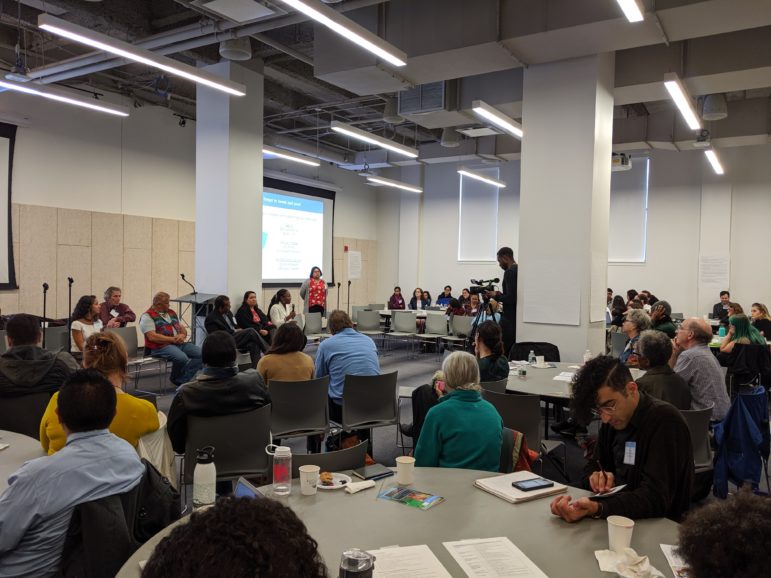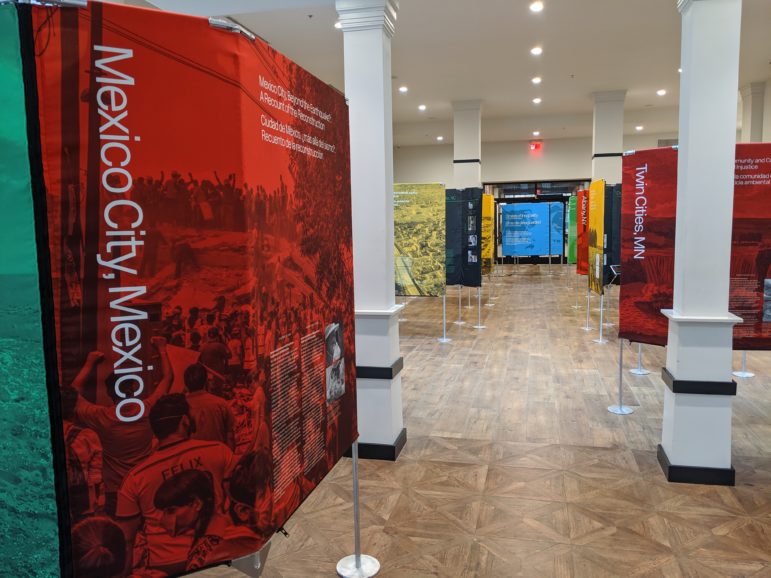
Newark hosted a global convening on environmental justice last week, and issues around how trash from South Orange, Maplewood and other surrounding towns is processed led the conversation.
The gathering included environmental justice advocates, students and scholars from around North America who have spent the last two years working on multimedia projects about how climate change is affecting their local communities. The resulting Climates of Inequality: Stories of Environmental Justice installation is on display at the Hahne’s Building Grand Court atrium in Newark until Dec. 15, after which it will travel to each of the other 19 cities where it was created.
“This is really our chance to start envisioning our future together,” Liz Ševčenko, director of the Humanities Action Lab, said during an introductory session of the conference at Express Newark on Thursday. HAL, the group behind this effort, includes universities, nonprofits and public spaces that collaborated on the project. By bringing such a broad set of institutions together in disparate cities, the project demonstrates how communities can take local action on the impact of environmental problems that they face.

The Newark team focused on the Ironbound neighborhood, an area adjacent to the city’s ports and home to one of New Jersey’s two garbage incinerators. For years, activists in that community have highlighted growing health issues such as asthma, autism and cancer that they say is a result of the toxins emitted directly into the neighborhood when garbage is burned there and when ships deliver goods from China and trucks drive through to pick them up.
All garbage picked up in South Orange and Maplewood, as well as 20 other municipalities, goes to the Covanta incinerator in Newark, where it is burned to produce energy. The facility opened in 1990 and processes 2,800 tons of garbage every day, according to the company website. Such waste-to-energy plants exist all over the world and are controversial. They keep garage out of landfills, but they also emit greenhouse gases and particulates such as sulphur dioxide and nitrogen oxides that have been shown to harm people.
It’s an important connection that should not be ignored, said South Orange Village Trustee Walter Clarke.
“This is a perfect example of why everyone, not just our towns, but all citizens, need to be aware of their consumption habits and refuse and reduce waste in the first place. There are many externalized costs in our consumer-driven society that are unfairly borne by small groups of people and are largely unknown to most,” he said. “The good news is consciousness seems to be growing.”
Clarke said the township has considered pay-as-you-throw models of waste disposal as well as other waste-reducing programs but has “yet to see a model that can work at our small scale and still be win-win.”
It’s not just the trash that links South Orange and Maplewood to Newark. Online orders shipped to doorsteps also frequently travel through the port there and are the reason why trucks barrel through the neighborhood every day. Ironbound residents are also subject to noise pollution from planes flying overhead to and from Newark Airport.
Filmmaker Julie Winokur, whose documentary The Sacrific Zone highlights the community’s struggle to hold the incinerator accountable for its emissions and was screened at Thursday’s event, led a panel of activists who discussed the role that residents living around Newark play in contributing to the problem.
Winokur, a Montclair resident, talked about living in the suburbs and being concerned about the impact her consumption has on the Ironbound neighborhood. She also asked the panelists how the many environmental justice groups in New Jersey could do a better job of working together.
Melissa Miles, a member of the Ironbound Community Corporation, said people concerned about environmental justice should start by getting educated on the issues and involved in their own neighborhoods.
“You flush your toilet, where does it go? You don’t know. It comes here. We smell that,” Miles said. “Go to your own planning boards and zoning boards and find out what’s happening there. We’re doing it here, you do it there, and then let’s talk about how we can collaborate.”
This story was produced in collaboration with the New Jersey Sustainability Reporting Hub project. It was originally reported by Ambreen Ali for VillageGreenNJ.com, and may be re-distributed through the Creative Commons License, with attribution.
